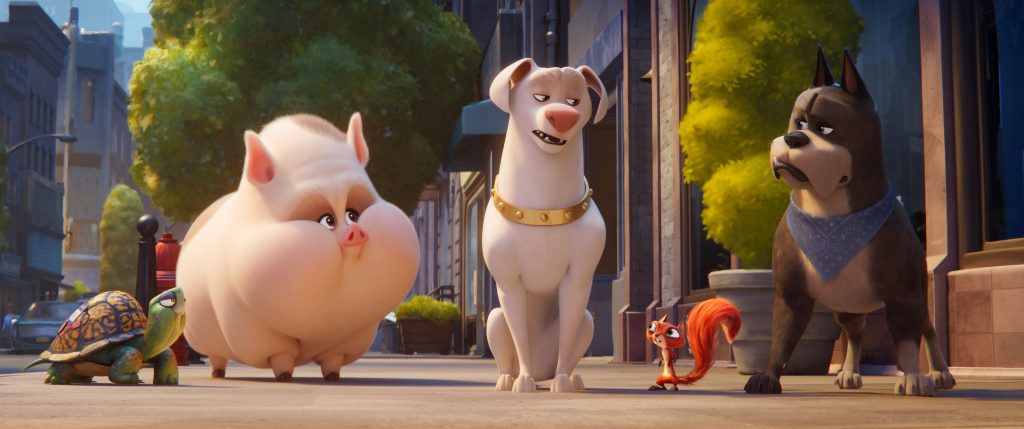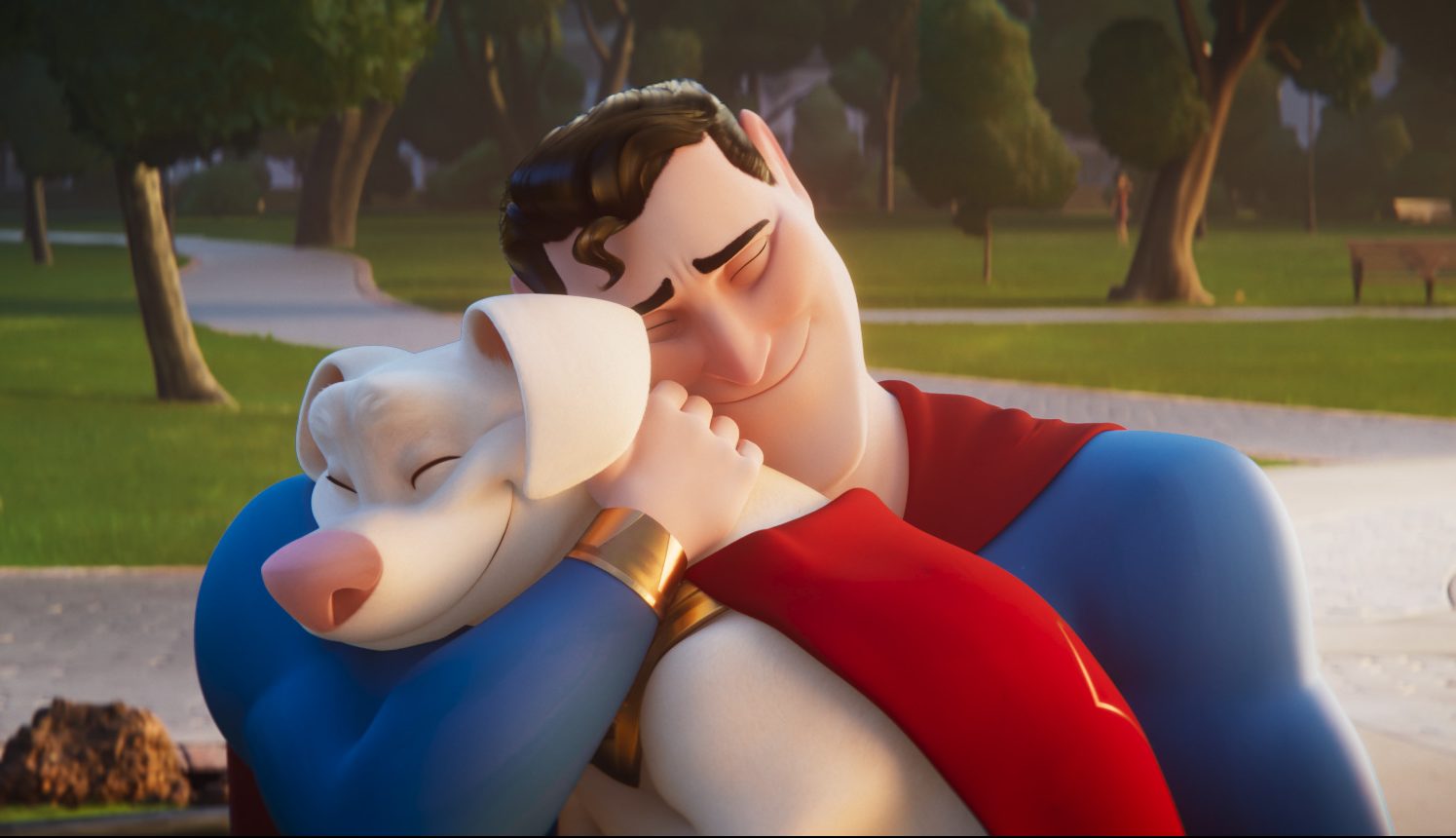What if you were a dog called Krypto (Dwayne Johnson), your bestest buddy in the whole world was Superman (John Krasinski) and you fought crime together in Metropolis on a daily basis? Could your friendship survive if Superman got himself a serious girlfriend, a savvy reporter at the Daily Planet newspaper called Lois Lane (Olivia Wilde), and he was imminently going to propose to her? Where does that leave Krypto?
This becomes the less urgent of Krypto’s problems when the Justice League is captured by the evil Lex Luther (Marc Maron) and it’s up to a scrappy mob of back room shelter pets to rescue them. They save Superman, Batman (Keanu Reeves), Wonder Woman (Jameela Jamie), Aquaman (Jemaine Clement), The Flash (John Early), Green Lantern (Dascha Polanco), and Cyborg (Daveed Diggs) from the evil Lex Luther and his dastardly protégée Lulu (Kate McKinnon), who doesn’t consider herself a drama queen at all despite her love of world domination and brooding iconic Hollywood actresses.
Writer/director Jared Stern (Green Eggs And Ham, Lego Batman Movie) spoke with Creative Screenwriting Magazine about putting his original spin on the familiar DC world in DC League of Super-Pets. “We told a superhero origin story. The audience is familiar with this.”
It all began when Jared Stern volunteered at an animal shelter for one day and noticed that that the cute kittens were generally adopted first, while the unloved, disabled animals were housed in the back. That’s where he appropriately landed on the idea that the animals in the DC Justice League Super-Pets were coming from a pet shelter.

Jared Stern. Photo by Kevin Scanlon
Stern drew from many comic book sources to create his unique super pets universe. Krypto and Ace (John Hart) had already appeared in various DC comics in the fifties.
Fortunately for Stern, the super pets from DC comics aren’t so well-known, so he could take some creative liberties in constructing their characters with co-writer John Whittington. Even if the animals were relatively obscure, the production team was mindful if something felt off. “You always want to be respectful of these characters. We looked at them through the lens of nobody having done a super pets movie before and we had fun with it.
“We paid homage to the DC superheroes, but also poked fun at them,” Stern continued.For instance, in looking at the character of Superman, he looked at him through the lens of being an over-protective pet parent wanting to find Krypto a new friend, in addition to being a superhero.
My dog’s the best, but he’s not the greatest with other animals… ~Superman
Apart from having more creative freedom, DC League of Super-Pets follows many traditional super hero story tropes. The super pets are terrible with their superpowers when they first acquire them and Krypto loses his superpowers before eventually getting them back after learning the value of teamwork for the greater good. “Krypto had to learn to live life without his powers for the first time and form a team with the other pets,” stated Stern.
Jared Stern flexed his creative muscles and dug into the DC canon in search of animals who might become super pets. “There’s a Bat-Cow, Streaky the Supercat, and even a Detective Chimp. There’s also the original legion of Super-Pets. Krypto the dog was one of them. There was also a horse and a monkey.” In one comic book, Wonder Woman flew on a pig and was turned into one in an animated TV series. So Jared didn’t need to invent a stable of pets. His aim was that each pet potentially could be found in a pet shelter and that a superhero might adopt them after their rescue.
I’m not really great with animals… ~Batman
Merton McSnurtle (Natasha Lyonne) the visually-impaired turtle came from an old comic called Funny Stuff who might be adopted by The Flash, while Chip The Squirrel could end up with Green Lantern, and PB the pig (Vanessa Beyer) could end up with Wonder Woman.
Jared Stern turned to The Secret Of Nimh and Plague Dogs for creative inspiration to write DC League of Super-Pets. He also watched Midnight Run & Planes, Trains & Automobiles to help shape the buddy story between Krypto and Ace. He considered romantic comedies like Wedding Crashers to structure the Superman-Krypto-Lois Lane (Olivia Wilde) relationship dynamics.
My best friend is in danger and you have to help me! ~Krypto
Hairless guinea pig Lulu and Lex Luther are the supervillains in DC League of Super-Pets. Lex manipulates Lulu. “Worthy villains need their own worldviews and must make a good thematic point,” said Stern. Lex scoffs at the notion of loyalty and camaraderie as he tosses her aside when she is no longer useful to him. Lulu has much to teach Krypto about himself and vice versa.
I am Lulu, and you will kneel before me! ~Lulu
The thematic spine of DC League Of Super-Pets examines the unconditional selfless love between a pet and its owner. “Lulu and Krypto both crave the love of their owners.” Lulu is positive she’ll eventually return to the love of Lex, while Krypto is not sure after Superman marries Lois. “Krypto thinks Lulu’s faith is misguided and she feels the same about his.” This dynamic drives the emotional spine of the whole film – sometimes Lulu is winning and sometimes Krypto is.
Animated Storytelling
Animation is a way to tell stories, so there is something about animated films that lend themselves to specific types of stories to warrant the time and expense in making them. “There’s a sense of playfulness and whimsicality that you might not get away with in live action,” pondered Stern. “There’s also a sense of caricature and fun to make them more universal.”
There is no hard and fast rule on why a movie should be animated. A live action film can conceivably also be animated, especially with technological advances.

Merton (Natasha Lyonne), PB (Vanessa Beyer), Krypto (Dwayne Johnson), Chip (Diego Luna), Ace (Kevin Hart). Image courtesy of Warner Bros. Pictures
“The storytelling process in animated films is so much more iterative than live action movies,” Stern mused. You don’t simply write a screenplay and hand it off to the production crew. Storyboard artists come on board early in the animation process, sometimes with their own story ideas. “This story building process continues through every stage of the filmmaking process and gets sent back to the writer.” The laborious and tedious process of animation ensures the tightness of the screenplay and that B or C plots don’t become distractions.
“You can only tell one story in a movie.” That said, Stern had to reduce the stories of the other super pets to bite-sized C-stories. “There still had to be small enough in the film to be satisfying and care about them enough to feel that they grew.” So long as the stakes are high enough, the emotional thrust of each character can be expressed in minimal scenes. “It’s about writing economically and efficiently.”
Although Jared Stern wrote the first draft of DC League of Super-Pets, he a shares writing credit with John Whittington. Due to the nature of animated films, “a lot of uncredited wonderful writers also worked on this movie. We had comedy round tables where people would pitch jokes. Some dialogue was drawn from the actors’ improv background and other story ideas came from the story artists. There were also three or four in-house writers at Warner Bros. who also offered their input.”
Jared Stern describes his writing voice as “irreverent comedy with warmth.” This is certainly apparent in the finished film. “The most memorable line I wrote is when Ace tells Krypto, ‘You can’t have justice without truth.’“
